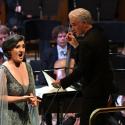It’s over 30 years since André Previn left his post as principal conductor of the London Symphony Orchestra. But once you’re part of the LSO’s treasured ‘family of artists’, the orchestra never lets go, year upon year inviting you back for Christmas, New Year, weddings, bar mitzvahs, any occasion going. The same with the violinist Anne-Sophie Mutter – briefly in the last decade Previn’s fifth wife, though they share the same platform with just as much ease now that they’re divorced.
Sunday’s unusually diverting concert formed part of the LSO’s "Artist Portrait" of Mutter: a portrait hardly required in one sense, for we all know what she looks and sounds like, and have so for decades. It’s easy enough to argue against the LSO’s continued cosiness with their ‘family of artists’ – what about the excitement of new blood? But aside from their artistry, big names bring the big audiences that every orchestra needs, even the comparatively well-endowed LSO.
The heart of Previn's music remains warm, pensive, and eloquently European
And along with trotting warhorses the LSO’s family do sometimes bring unusual repertoire. Without Previn’s advocacy, when we would we have heard the intriguing and entertaining Third Symphony of John Harbison? An American eclectic approaching his mid 70s, Harbison has so far managed to win the Pulitzer Prize for music (1987), write five symphonies, and make operas from The Great Gatsby and The Winter’s Tale without raising an eyebrow in Britain, let alone making a dent.
The symphony (dated 1990) began with descending cadences suggesting it was reaching its end – a very Haydn-esque joke. Other references and sounds in its 25-minute journey took us far beyond Haydn’s ken. Jazz wandered in; Sibelius too; plus hammered grimaces, snake-charming winds, and the semi-pitched clunks of the lujon, a percussion instrument dreamed up by the Modern Jazz Quartet’s John Lewis. The five linked sections’ block construction restricted the symphony’s momentum. But nothing lessened its imaginative textures, technical finish (often the mark of a Walter Piston pupil), or the intriguing push-and-pull between forces trying to end the work’s argument and those trying to push it forward.
Perched on a swivel seat reached after a slow, precarious journey – Previn’s physique, alas, gets frailer and frailer – our conductor handled the piece most effectively with the limited expressive force at his command. The baton in the right hand neatly beats out the rhythms; the left hand points up the entries and closes them off. Dynamic changes seem to arrive by osmosis. It happened that way in Copland’s Appalachian Spring suite, verdant and lovely, despite a bassoon at one point coming in too soon. It was so too in the piece that needed Mutter and Yuri Bashmet: Previn’s own Concerto for Violin, Viola and Orchestra, completed in 2009. This was its European premiere.
This is Previn’s fourth concerto to feature a violin composed in what you might call his Mutter period. Gone, happily, are the garrulous fidgets of the 2001 concerto for violin alone; the timespan is shorter (25 minutes), the mood more concentratedly nostalgic. The older he grows, the more Previn’s concert music seems to draw on his German childhood and heritage. Here in this double concerto Richard Strauss is summoned; the Hollywood Korngold too, with rippling harp underpinning singing strings; while the finale sets off for a time with an artless tune fit for a nursery rhyme. Brash and percussive Americans eventually barge in, but the music’s heart remains warm, pensive, and eloquently European.
With her violin’s silvery gleam, Mutter had no problem finding the concerto’s soul, soaring and winding often in tandem with the viola. But duetting with a viola is rarely in a viola’s interests, an instrument always acoustically inclined to sit in the violin’s shadow. This was definitely the case here. Bashmet furthered the imbalance by muddying some of the chromatic intervals and keeping his sound muted; it's as if he was playing while wearing gloves. A pity, this, for the work has real strengths, even charm, and deserves a long life. So does the affable and popular Previn; though with platform manoeuvring getting so difficult you have to wonder how much longer he can keep visiting his LSO family for Christmas, bar mitzvahs, the Fourth of July...















Add comment